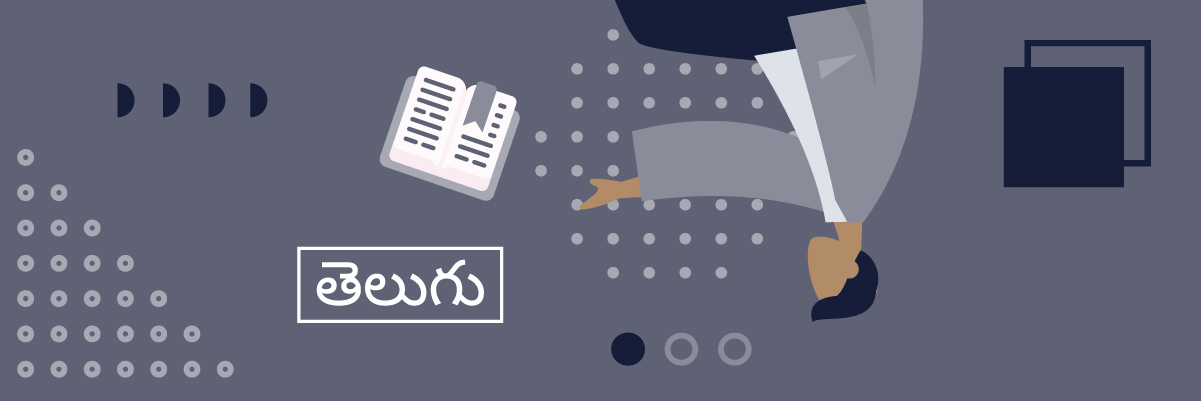How do you handle one of the largest languages in India? To do so, you need to involve Telugu translation. Just look at the basic facts. According to Britannica, the Telugu language is the largest member of the Dravidian language family. It is primarily spoken in southeastern India. At the same time, it is the official language of the states of Andhra Pradesh and Telangana.
But how many people use the Telugu language in their daily life? According to the same source, in the early 21st century Telugu had more than 75 million speakers. But, also, Telugu is the language of quite a hefty number of films and TV series that come out of India. According to The News Minute, only in 2019, there were 190 “straight Telugu films and scores of other dubbed films vying for the attention of the audience.”
Historically, the first written materials in the language date from 575 CE. The Telugu script derives from that of the 6th-century Calukya dynasty and is related to that of the Kannada language. Telugu literature begins in the 11th century with a version of the Hindu epic Mahabharata by the writer Nannaya Bhatta (Britannica, above).
It is also important to note that there are four distinct regional dialects in Telugu. Also, as well as three social dialects that have developed around education, class, and caste. The formal, literary language is distinct from the spoken dialects—a situation is known as diglossia.
Just this brief information shows the importance of Telugu translation, to and from the language. And as is the case with any other language there are specific elements to note when doing the translation.
Telugu people and the Telugu language
Telugus or Telugu People are one of the four major and the largest Dravidian ethnolinguistic group in terms of population native to the South Indian states of Telangana, Andhra Pradesh, and Yanam district of Puducherry. Significant Telugus also reside in the surrounding Indian states of Karnataka, Tamil Nadu, Maharashtra, Chhattisgarh, and Odisha, also in the UT of Andaman and Nicobar Islands. The Telugus like some other South Asians largely descend from a varied mixture of Pre-Dravidian tribes, Dravidian, and Indo-Aryan people.
Indian diaspora of Telugu origin is widespread, especially in the USA, Myanmar, Malaysia, South Africa, Australia, and Canada. The Telugu language is the 4th most spoken in the Republic of India and the 15th most spoken language in the world. The overall number of speakers is estimated at nearly 82 million (above source).
Lotus Tech notes that “Telugu has heavily borrowed from Sanskrit. Other languages that contributed to its development are English, Urdu, and Persian. Telugu is extensively used in government, media, law, and other walks of life. It is also the medium of instruction in many government schools and colleges. Aspirants to government jobs can appear for the qualifying examinations in Telugu.”
Omniglot examines some of the specifics of the Telugu language.
Telugu has a writing system with a “syllabic alphabet in which all consonants have an inherent vowel. Diacritics, which can appear above, below, before or after the consonant they belong to, are used to change the inherent vowel.”
When they appear at the beginning of a syllable, vowels are written as independent letters. When certain consonants occur together, special conjunct symbols are used which combine the essential parts of each letter. The direction of writing is left to right in horizontal lines.

Telugu translation – challenges and solutions
As you can notice from the brief notes on its history, Telugu ranks as one of the older languages in existence. But, at the same time, it is a live language that is a subject of extensive linguistic studies.
But how do you proceed with translation to and from Telugu? Of course, there are some general steps as in every translation that apply.
One experienced translator explains how you can tell when a translation is good. Here are her tips:
- Being a native speaker is not enough. Translators should also be good writers.
- A good translation doesn’t sound like a translation at all. It sounds like a good text.
- Good translators use their heads and have the courage to make improvements.
- Excellent translations are the result of teamwork.
- Clients also play a role in the creation of good translations – by providing good briefings (you may find more detailed tips on translation in general HERE).
But what about the specifics of Telugu translation? Lotus Tech (above) tackles that question with detailed examples. The note first that “English language mechanics are different from those of Telugu. English lets you play around with the placement of the subject or object at the beginning of the sentence. However, if we imitate the same in Telugu, it reads avoidable.”
In Telugu, writing the second alternative, even if we want to emphasize the subject, reads very colloquial at best and meaningless at its worst. Telugu has many alternatives. That is why the author notes that “Things can get complex quickly when translating content from English to Telugu.” He presents that through an example sentence from a white paper:
‘Growth of the Industrial and Services sector is critical (a) to achieve the 12-13% overall economic growth (b) to create employment and (c) to increase per capita income. (d)’
“The translation reads best in Telugu when we bring (b), (c), and (d) to the beginning of the sentence.”
More on challenges and solutions
The same author also notes the problem of translating idioms. “Idioms in English (for that matter those from any language) sparingly lend themselves to translations. A translator should find something close enough in his language or write in such a way that the writing comes close to the original. The same argument goes for sayings in English as well.”
Then, there is the question of vocabulary. Lack of terms can be a huge hindrance. English is enriched every day with words from the world of technology, economics, science, politics, and so on. However, the regional dictionaries have no way to cope up with the pace. The regional versions of these new words are either unavailable or, are a far cry from the original. Even when the regional versions are available, they don’t have the ‘vibe’ of the original.
For example, the word ‘transformation’ can be used as a very positive word in English. However, in Telugu, the closest is ‘roopantharam’ (రూపాంతరం) or ‘roopantharamu’ (రూపాంతరము). In Telugu, it is mostly used in science to indicate ‘metamorphosis’. Another alternative ‘Parinamamu’ (పరిణామము) also indicates evolution. And both words are a far cry from the positive vibes of ‘transformation’(above source)
A problem can arise with regional names and words. “When a non-native speaker writes about a regional happening in English, it is likely that the writer is unaware of the meaning of the regional word and makes a mistake. Another source of mistakes occurs when the English version comes from a writer who doesn’t speak the regional language, (here, Telugu). When he must include the regional names, he is likely to make mistakes.”

Film industry – an abundant source of Telugu translation
The above author points out a specific problem with spellcheckers. With the Telugu language pack installed, I noticed that MS Word could point out a mistake, only when the word doesn’t exist in the language. However, if you write two unrelated words that are meaningless together but are meaningful separately, MS Word doesn’t recognize that the pair is awkward or wrong. So, the onus of finding such mistakes is on the translator.
This spellchecking problem can turn out to be quite important in one of the large fields of Telugu translation – the film industry. These days, everybody is familiar with Bollywood, the main Indian version of Hollywood. But the film industry in India that makes films in Telugu is so big that it itself is billed as ‘Tollywood.’
The Telugu film industry is one of the three largest film producers in India. About 245 Telugu films were produced in 2006, the highest in India for that year. According to the latest info, as of January 2021, “Telugu film industry is on an overdrive with nearly 70 feature films, series, OTT films under production right now.”
Kangana Ranaut is one of the star heroines in the Indian film industry. She came up with the comments that the Telugu film industry is top in the country and Bollywood stands only after Telugu. “People’s perception that top film industry in India is Hindi film Industry is wrong. Telugu film industry rose to the top position and now catering films to pan India in multiple languages, many Hindi films being shot in Ramoji Hyderabad.”
Obviously, the Telugu film industry is one of the larger sources for Telugu translation. But, for a translator to be effective here and come up with the best results, he would probably have to have an excellent knowledge of that industry. Of course, that is along with the excellent knowledge of Telugu and the other source or target language.
Concluding remarks
While the Telugu film industry is one of the key sources from and to Telugu translation, it certainly is not the only one.
The fact that the number of speakers of Telugu is anywhere between 75 and 82 million speakers only underscores the importance of Telugu translation. A sizeable Telugu diaspora, particularly in the English-speaking part of the world further underscores its importance to and from the English language.
Getting a good Telugu translation of course depends on the quality of the translator or translators you plan to engage. Fluency in both Telugu and the target language is one of the aspects. Good knowledge of localization aspects is another. Here, at Bunny Studio there is also a possibility you can find solutions. We offer freelance translators that can help you with all your Telugu translation needs.










